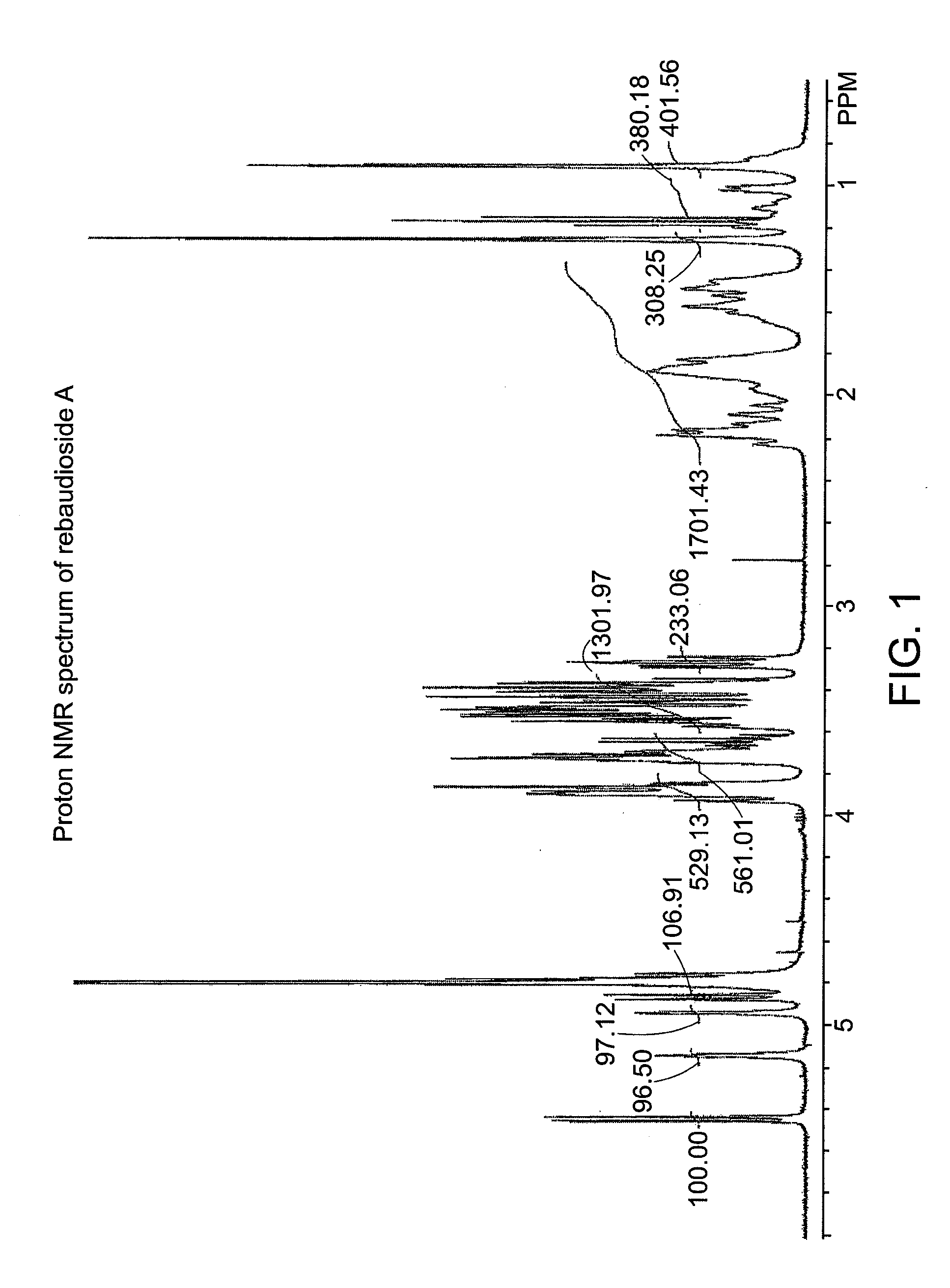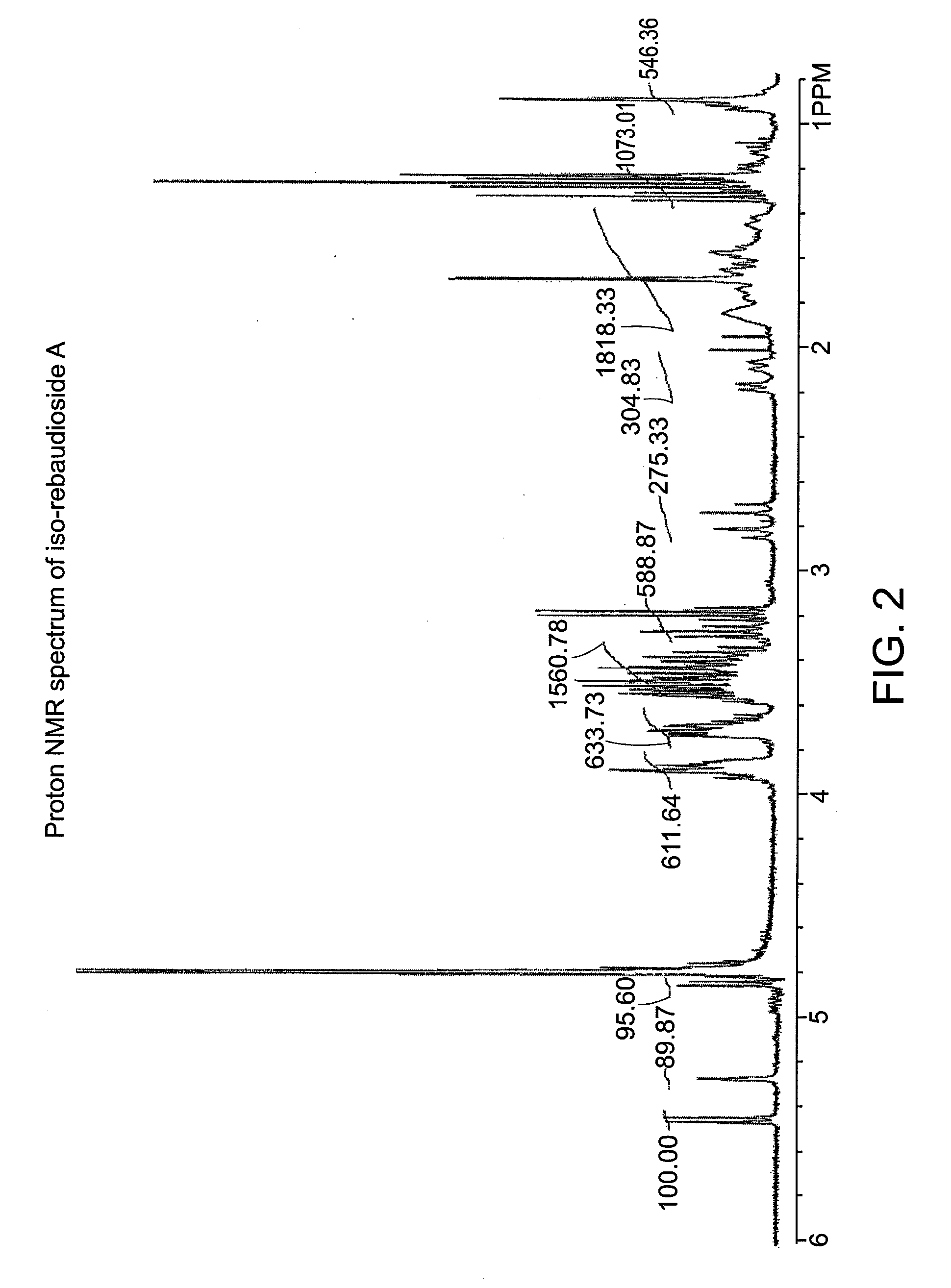Steviol glycoside isomers
a technology of steviol glycosides and isomers, which is applied in the direction of sugar derivates, esterified saccharide compounds, food preparation, etc., can solve the problems of off-taste of the replacement of nutritive sweeteners with known potent non-nutritive sweeteners
- Summary
- Abstract
- Description
- Claims
- Application Information
AI Technical Summary
Benefits of technology
Problems solved by technology
Method used
Image
Examples
example 1
[0049]Synthesis of iso-rebaudioside A: Rebaudioside A (0.5 g) dissolved in an aqueous citrate buffer solution (about pH 2.0) was heated for 10 weeks at about 43.3° C. The reaction mixture was then freeze-dried and then subjected to a silica gel column (1×20 cm) eluting with a solvent system of 70% acetone, 15% triethylamine, and 15% water. Two fractions were isolated, with fraction 2 containing rebaudioside A and iso-rebaudioside A. After concentration, approximately 6 mg of oil was isolated from fraction 2. The oil was dissolved in D2O (0.6 mL) and left at room temperature for about three days. Clear, colorless needle crystals (1-2 mg) formed and were isolated for analysis.
example 2
Analysis of iso-rebaudioside A
[0050]A small amount of the crystalline product of Example 1 was analyzed by proton NMR and compared to the parent rebaudioside A spectrum (D2O, 400 MHz 1H-NMR). The two compounds were not identical, which showed that a new isomer had formed. FIGS. 1 and 2 contain the proton NMR spectra of a rebaudioside A standard and iso-rebaudioside A, respectively. FIG. 3 shows an overlay of the two spectra.
[0051]Samples of rebaudioside A standard and the crystalline product of Example 1 were submitted for mass spectral analysis (ESI positive ion mode). Both compounds showed the expected molecular weight for rebaudioside A of 966.5 amu and similar fragmentation patterns. FIGS. 4 and 5 show the mass spectra of rebaudioside A and iso-rebaudioside A, respectively.
[0052]Analyses were performed on a C-18 reverse-phase analytical column (Alltima 2.1×250 mm) at a flow rate of 0.250 mL / min with detection at 210 nm, and evaporative light scattering (ELSD) detection. The colu...
example 3
[0056]Synthesis of iso-rebaudioside A: Rebaudioside A (5 g) was dissolved in an aqueous solution of citrate buffer (pH 2, 100 mM, 200 mL) and heated to about 75° C. The reaction progress was monitored via HPLC and when the ratio of iso-rebaudioside A to rebaudioside A was greater than 75% (72 hours) the reaction mixture was evaporated to a sticky crystalline solid. The product mixture was passed through a silica column (10×40 cm) eluting with acetone:water:triethylamine (70:15:15) to provide a glassy oil (about 1.0 g). Analysis by HPLC showed the presence of rebaudioside A and iso-rebaudioside A along with a large amount of apparently hydrolyzed material corresponding to the loss of one or more sugar moieties (e.g., iso-stevioside, iso-rebaudioside B, iso-rubusoside, iso-steviolbioside, iso-steviolmonoside, etc.).
[0057]The glassy oil was dissolved in water (3 mL) and separated by semi-preparative HPLC (Alltech Alltima C-18 semi-preparative column, 10×250 mm, flow rate 5 mL / min, solv...
PUM
| Property | Measurement | Unit |
|---|---|---|
| temperature | aaaaa | aaaaa |
| temperature | aaaaa | aaaaa |
| temperature | aaaaa | aaaaa |
Abstract
Description
Claims
Application Information
 Login to View More
Login to View More - R&D
- Intellectual Property
- Life Sciences
- Materials
- Tech Scout
- Unparalleled Data Quality
- Higher Quality Content
- 60% Fewer Hallucinations
Browse by: Latest US Patents, China's latest patents, Technical Efficacy Thesaurus, Application Domain, Technology Topic, Popular Technical Reports.
© 2025 PatSnap. All rights reserved.Legal|Privacy policy|Modern Slavery Act Transparency Statement|Sitemap|About US| Contact US: help@patsnap.com



